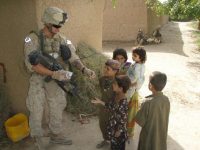Memo #305
By Dur-e-Aden – dur-e-aden [at] hotmail.com
 While fighting an insurgency, it is important never to harm civilians. Doing so will increase recruitment for insurgent groups and result in fuelling the conflict. This is known as the “population-centric” counter-insurgency doctrine. By this logic, it also follows that if insurgents use violence on the local population, that population should turn against them and support the military forces in rooting them out.
While fighting an insurgency, it is important never to harm civilians. Doing so will increase recruitment for insurgent groups and result in fuelling the conflict. This is known as the “population-centric” counter-insurgency doctrine. By this logic, it also follows that if insurgents use violence on the local population, that population should turn against them and support the military forces in rooting them out.
However, a recent study of the Afghanistan context concluded that civilian responses to violence in an insurgency are in fact asymmetrical (Lyall et al. 2013). After conducting surveys in areas known as the “heart of the Taliban insurgency,” this study found that while violence by the NATO-led International Security Assistance Force (ISAF) resulted in less support for foreign forces and more support for the Taliban, violence inflicted by the Taliban did not translate into greater support for ISAF and only had a marginally negative effect on Taliban support. People tended to interpret the actions of one’s own group more favourably than those of the out-group, a tendency known as “inter-group bias.” For example, if a Taliban placed-IED kills civilians, instead of blaming the Taliban, the local population might reason that had the ISAF not been there, Taliban never would have placed the IED in the first place.
These findings can help explain why anti-Americanism has not decreased in Afghanistan despite a relative improvement in US military tactics. Just like in the past, when the “shock and awe” doctrine based on the overwhelming use of force met its limitations as the Iraq war unfolded, so too there might be limitations to the current “population-centric” doctrine, where the underlying logic makes perfect sense in theory, but plays out very differently on the battlefield.
These research findings may also prove relevant not only to forces fighting in a foreign country, but also for local forces operating within their own multi-ethnic country. If Afghan Security Forces conduct military operations in areas composed of minority ethnic groups, they can also encounter an “out-group bias.” Hence, any assumption that handing over Afghanistan’s security to indigenous forces will result in a decrease in insurgency is too simplistic, especially when indigenous can mean a lot of different things in different contexts.
About the Author:
Dur-e-Aden is a MA student in the Department of Political Science at the University of British Columbia.
- Afghan and coalition forces conduct counter-insurgency operations in Muqer district, Ghazni province, Afghanistan (Credit: Michael Mulderick).
- During counter-insurgency operations in Marjah, Afghanistan in 2010, a U.S. Marine hands out candy to the local Afghan children (Credit: Puckett88).
-
Links:
- David Kilcullen, The Accidental Guerrilla: Fighting Small Wars in the Midst of a Big One, Oxford University Press, 2009
- Jason Lyall, Graeme Blair and Kosuke Imai, “Explaining Support for Combatants during wartime: A survey experiment in Afghanistan,” American Political Science Review, November 2013
- Jon Boone, “Most Afghan civilian deaths ’caused by Taliban attacks, not US forces’,” The Guardian, March 2011
- Karl W. Eikenberry, “The limits of Counterinsurgency in Afghanistan,” Foreign Affairs, September/October 2013
- Stephen Biddle, “Ending the war in Afghanistan,” Foreign Affairs, September/October 2013
Related Memos:
See our other memos on Afghanistan.


Comments are closed, but trackbacks and pingbacks are open.